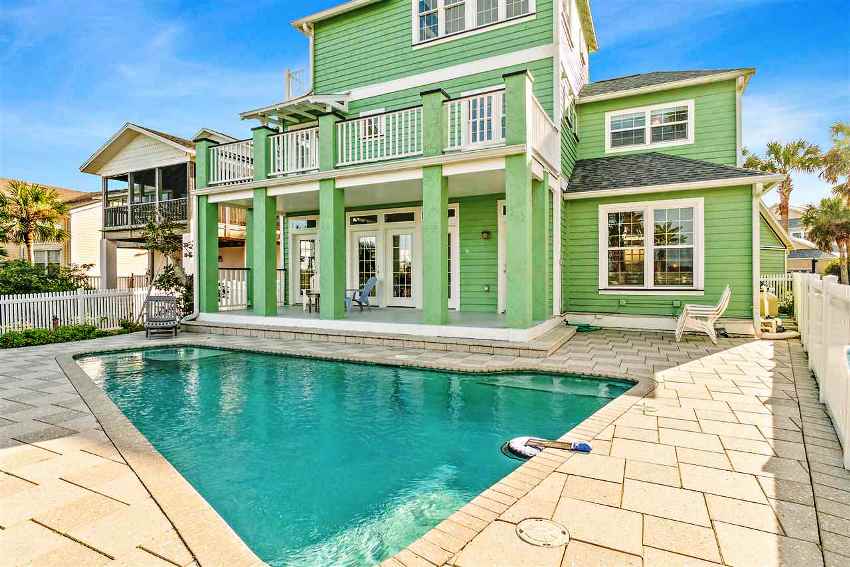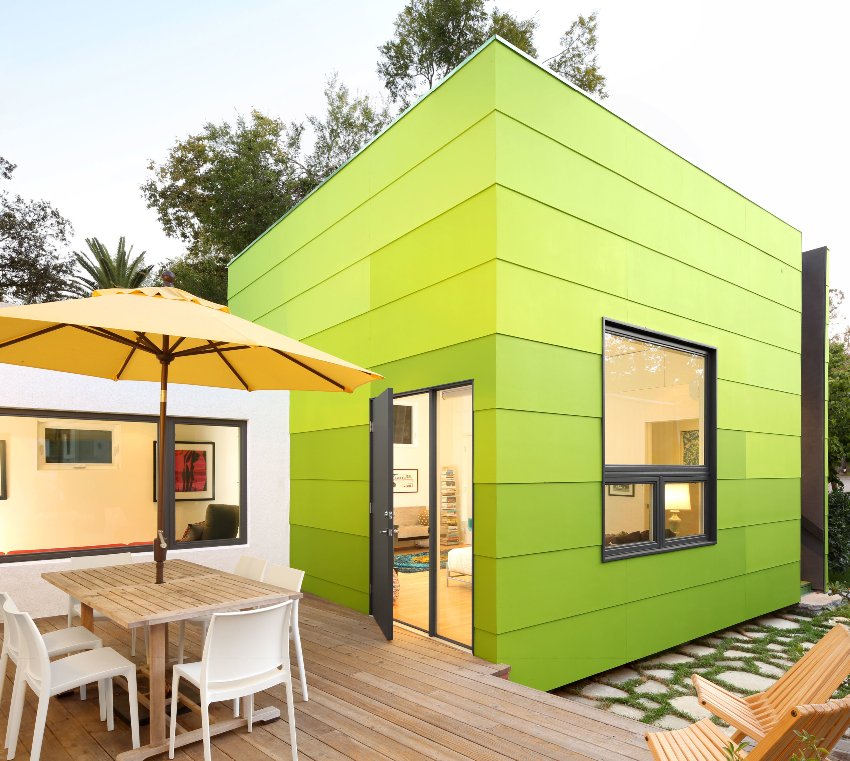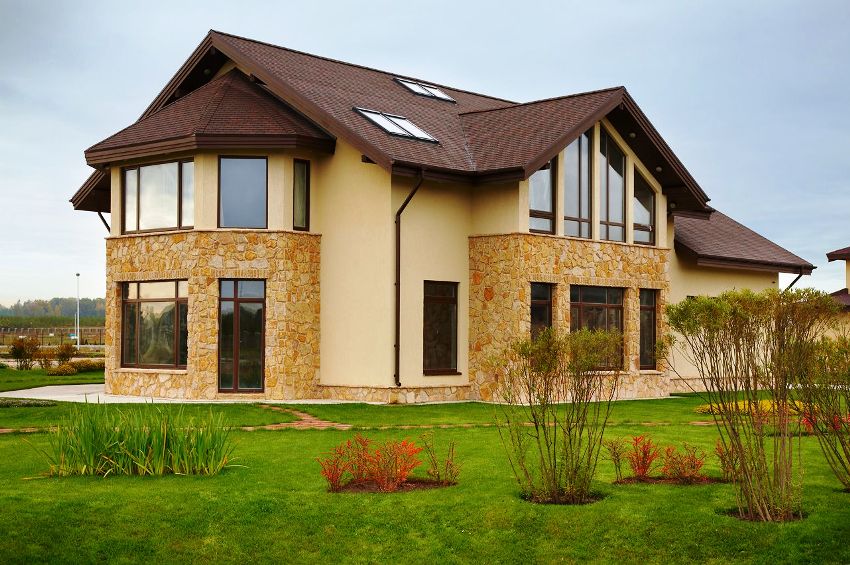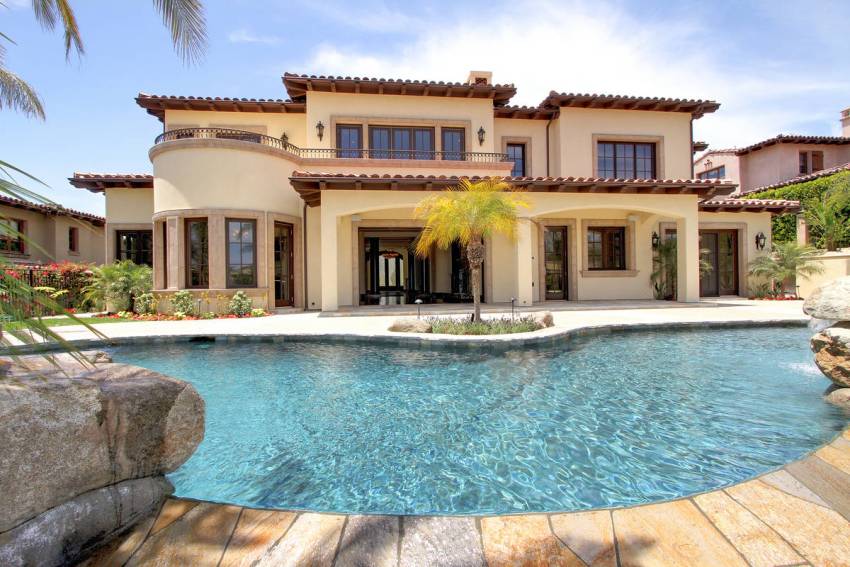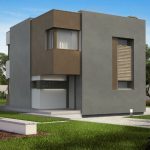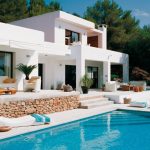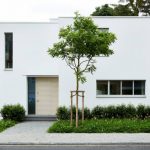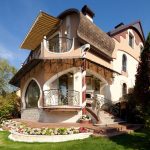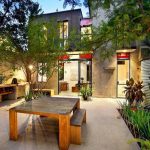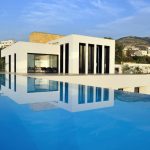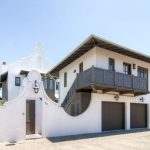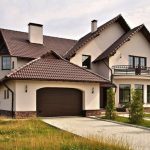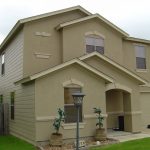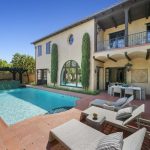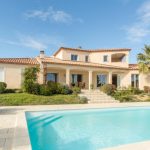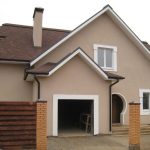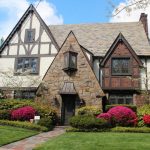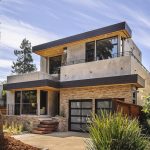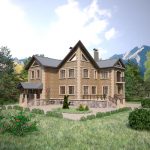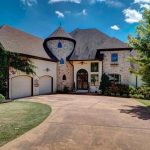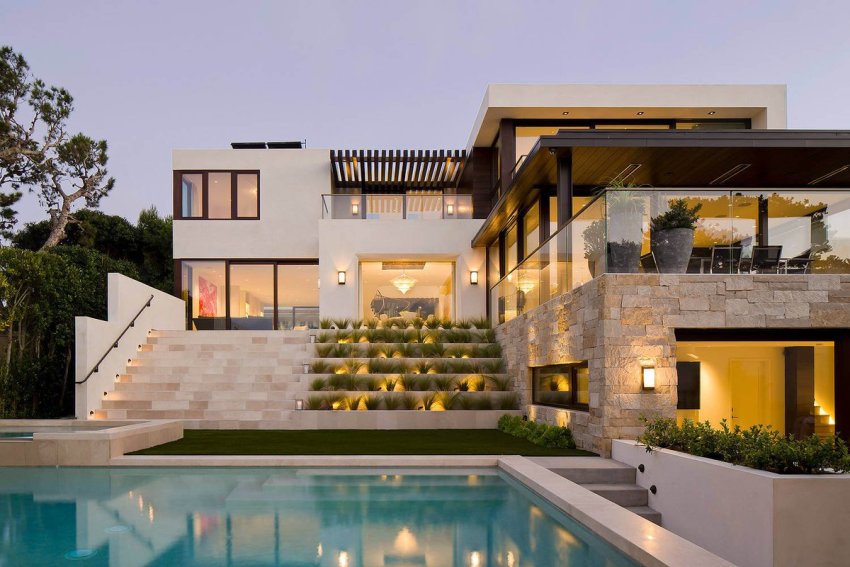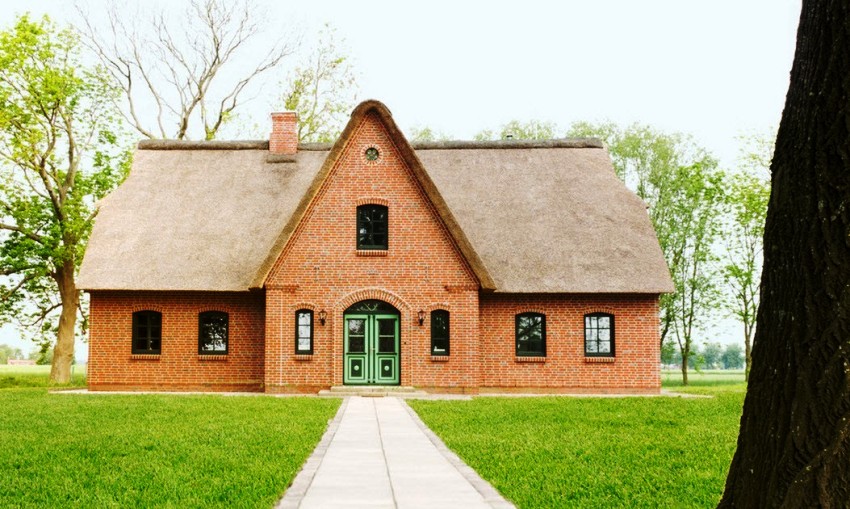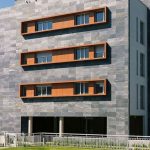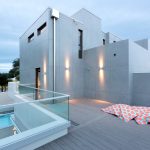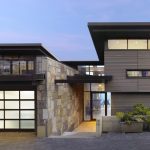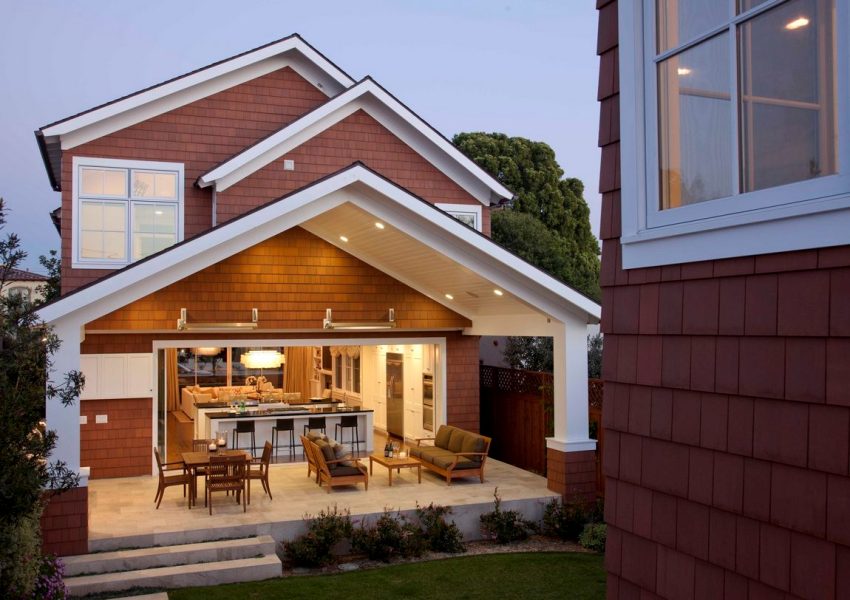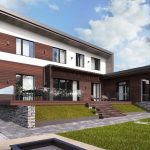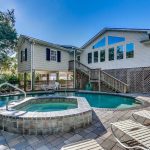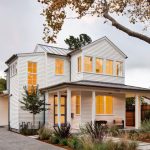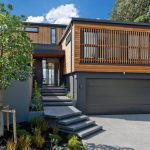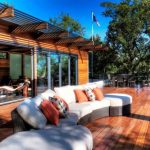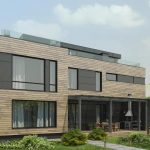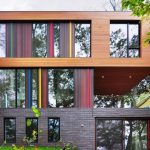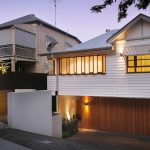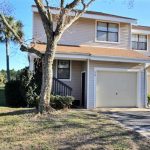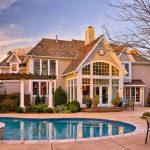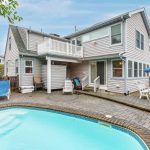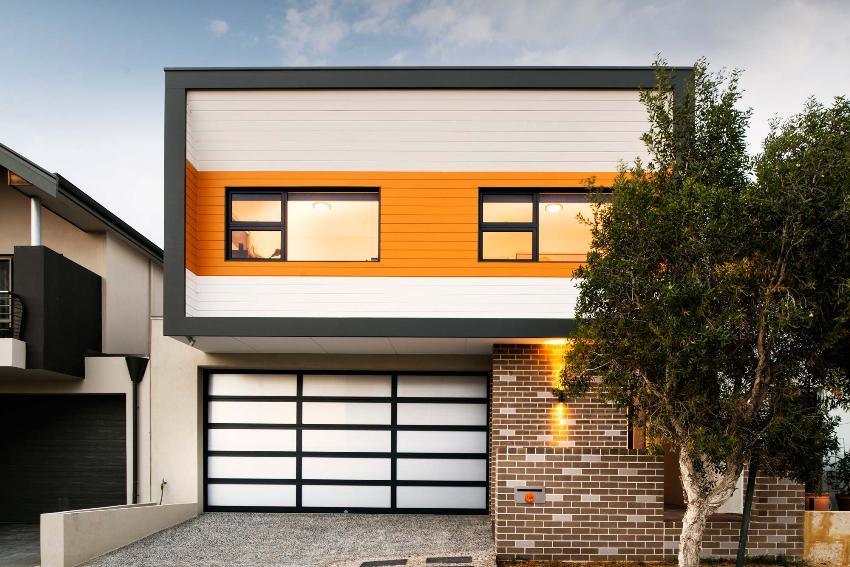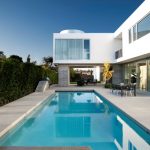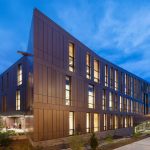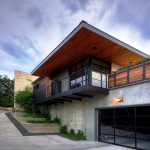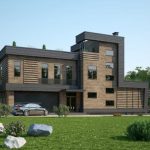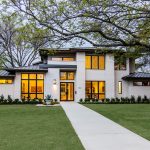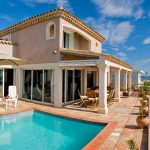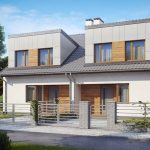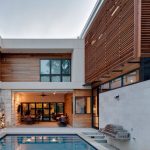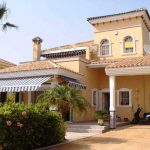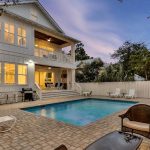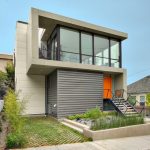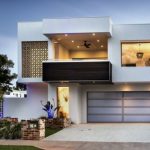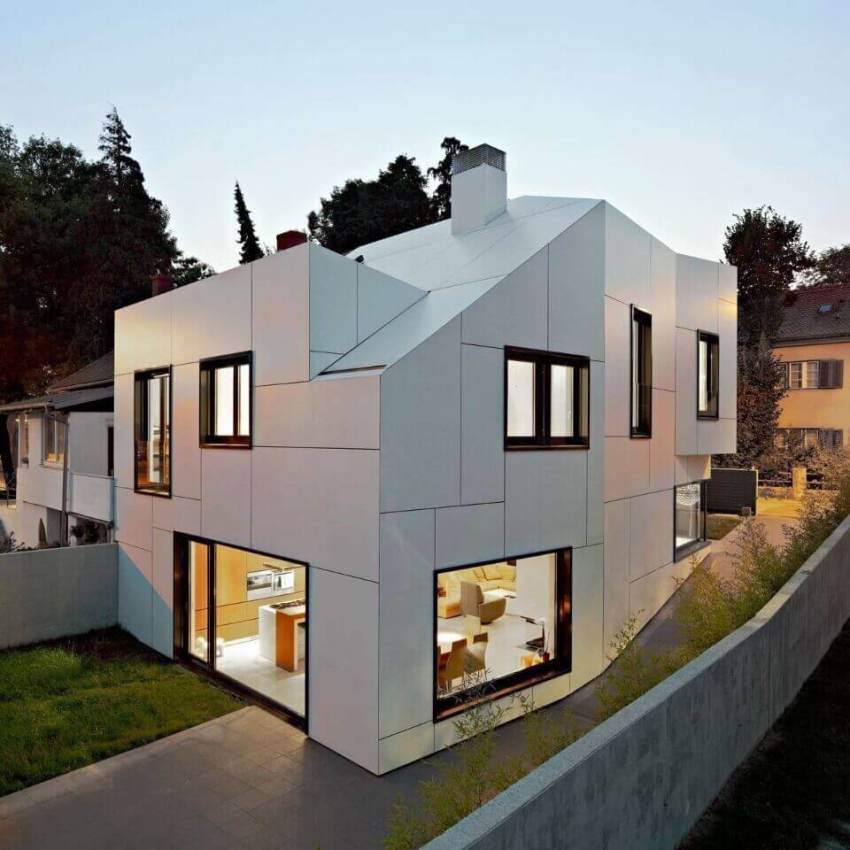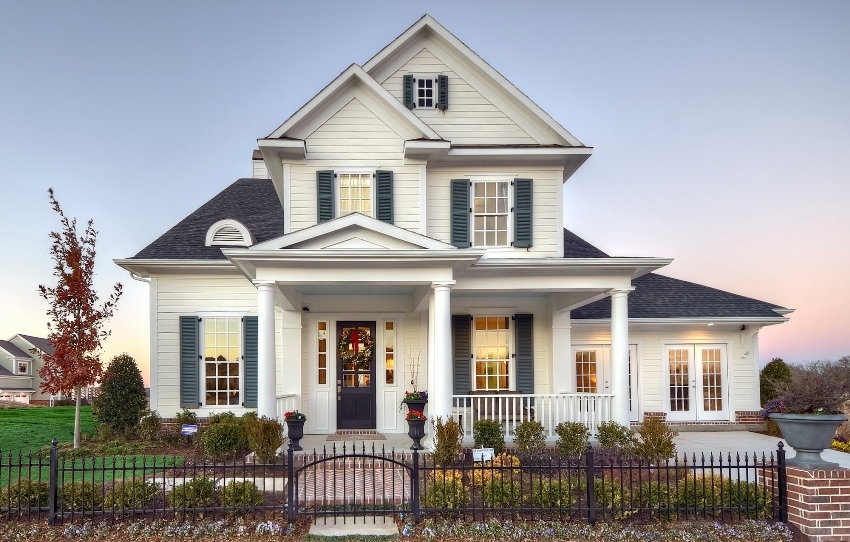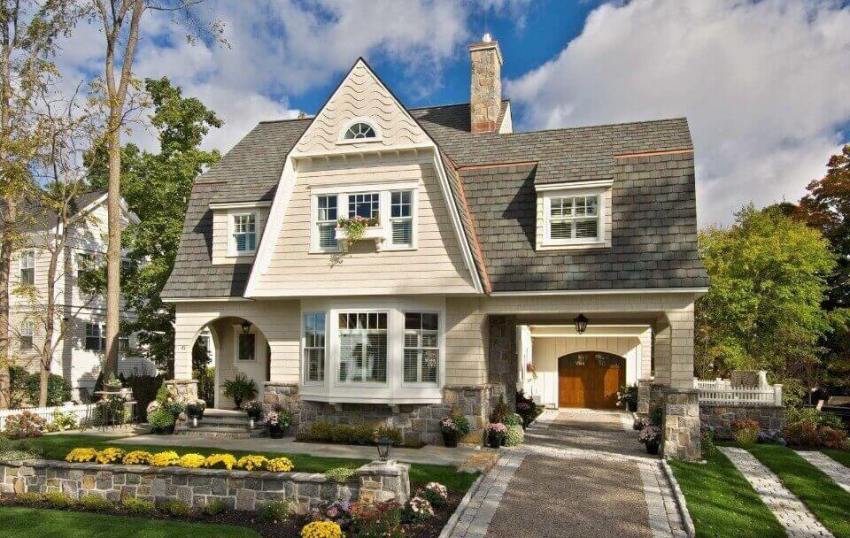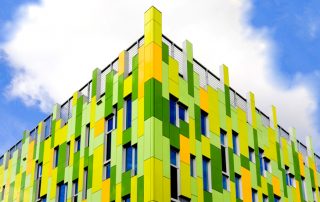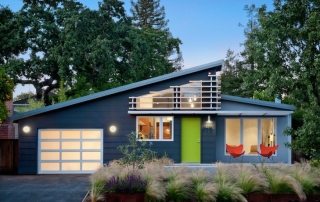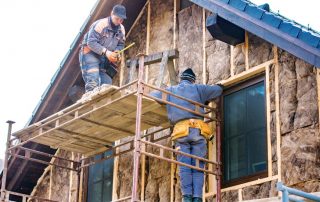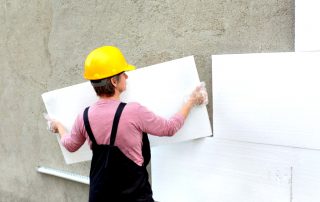Exterior decoration not only plays a decorative role, but also serves as the main element of protection of load-bearing walls. Correctly selected facades of houses carry out thermal and sound protection functions, prevent moisture penetration and protect building frames from the negative effects of wind, temperature extremes, and the sun. The main requirements for facade decoration are an attractive appearance, stability, the ability to resist the reproduction of microorganisms.
Content
- 1 The main methods of finishing the facade of the house, criteria for choosing materials
- 2 Basic requirements to be met by the materials used for facing facades
- 3 Facades of houses: plaster as an excellent finishing option that protects the base
- 4 Natural and artificial stone when decorating the facades of houses: photos of finished options
- 5 What does house decoration look like with facing bricks?
- 6 Porcelain stoneware, ceramic and concrete tiles for the facade of the house
- 7 Siding as a popular option for exterior facade decoration: photos of beautiful houses
- 8 Exterior decoration of the house with fiber cement facade panels, metal and cement siding
- 9 Modern trends used in the design of facade design
- 10 Why do you need to carry out timely repair of the facade of the house
The main methods of finishing the facade of the house, criteria for choosing materials
It is recommended to choose a material for finishing the facade of a private house at the stage of creating a project. Due to the fact that most retail outlets offer a wide range of options, you can choose a finishing method that will suit both in appearance and in price. When buying building materials, it is important to consider that the facade of a house is, first of all, the face of any building; it must fit into the surrounding exterior. When choosing materials, it is also necessary to ensure that they perform a protective function, hold and regulate the temperature inside the house well, play a sound-protective role and prevent premature destruction of the building box.
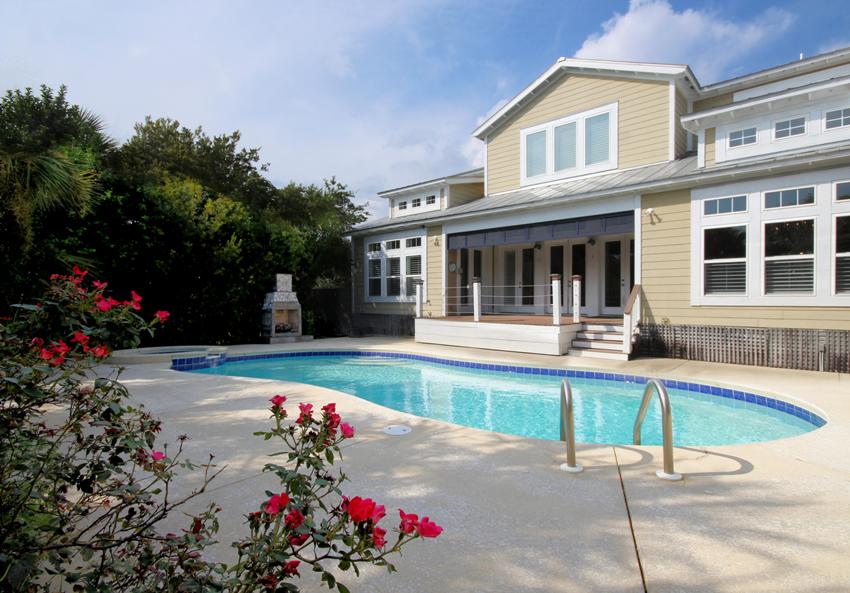
The material with which the design of the facade of the house is carried out should not show a tendency to weathering or washout
Correct cladding consists not only in choosing the optimal material, but also in observing a certain laying technology and working order. Whichever variant of facade finishing is discussed, each of them is distinguished by a clearly developed technology, which guarantees durability.
Important! If you follow all the recommendations when cladding and adhere to the laying rules, then the guaranteed service life of the facade can reach 30-50 years.
In general, there are two types of finishing the facade of a private house:
- hinged ventilated facade;
- "Wet" facade.
The essence of a ventilated façade is to mount a rigid cladding on a frame subsystem. In this case, one of the following facade materials is used:
- siding;
- porcelain stoneware;
- metal composite sheets.
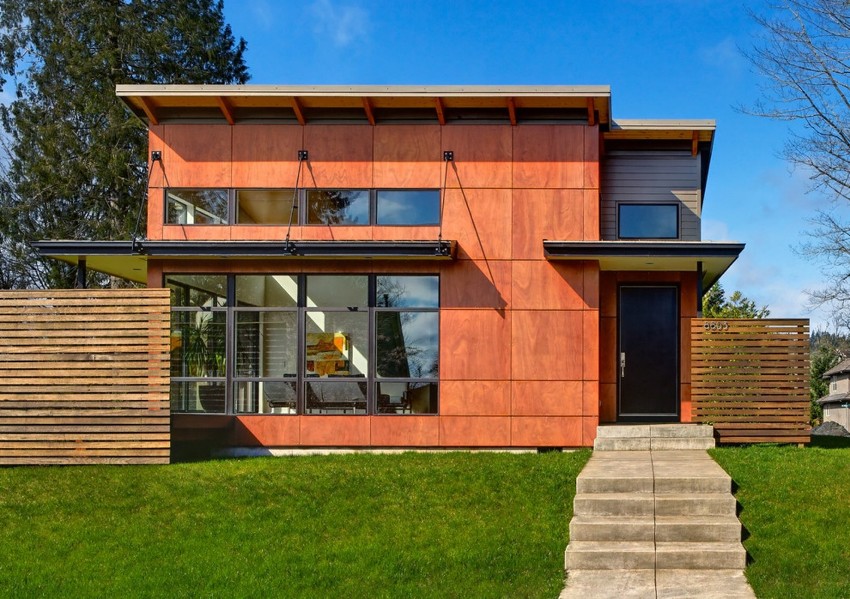
The external cladding of the facade must be very attractive in order to successfully blend into the surrounding area.
When creating a ventilation facade, it is required to maintain proper air circulation under the outer cladding, which will prevent the formation of condensation on the outer surface. It is recommended to use this finishing method if the thermal protection belt contains mineral insulation that is prone to the accumulation of excessive moisture. Due to the fact that the external decoration is ventilated, the condensation will evaporate. It should be noted that the cost of this finishing option is considered one of the most expensive due to the complexity of installation.
The so-called “wet” façade includes façade finishing technologies associated with plastering. In this case, the surface will consist of two layers: first, the insulation is laid (most often it is polystyrene or expanded polystyrene), then there are reinforcing and decorative layers that are securely fastened to each other. Despite the fact that laying such a facade is somewhat simpler than the previous method, its durability will directly depend on the quality of the selected materials and the work done correctly.
In this case, you can save a little on materials, but the work of the craftsmen will not cost much less than when laying a ventilation facade. The advantage of cladding is considered to be an improved protection of the frame from negative atmospheric influences.
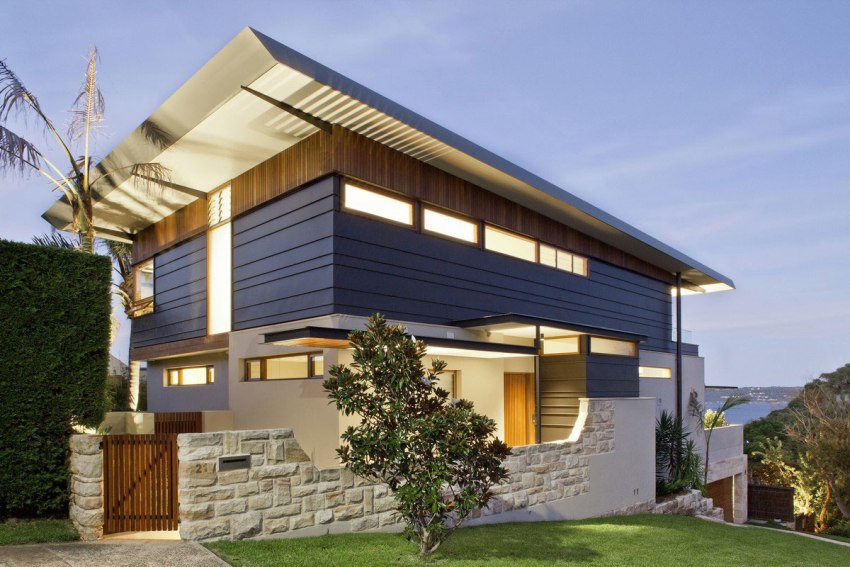
Facade finishing material must be resistant to efflorescence, aggressive environments, mold and mildew
Basic requirements to be met by the materials used for facing facades
A variety of building materials presented on trading floors differ in composition, characteristics, appearance and other indicators. To determine which options for finishing the facade of a private house are better, what to choose in a particular case, you need to pay attention to the following criteria:
- Stability and reliability. The facade of the house is constantly experiencing various kinds of stress, this includes not only atmospheric influence, but also mechanical damage, which the finish must withstand.
- Ability to resist moisture build-up. The better and longer the materials repel moisture, the longer the facade can be used without damage.
- Fire resistance. The most suitable finishing material for facades is considered to be a non-combustible option. And although almost none of the claddings will be able to withstand a fire, it is important that the characteristics indicate the absence of the ability to self-ignite when exposed to high temperatures.
- No sunburn problem. The exterior of the building is constantly in direct sunlight, and materials that fade quickly can ruin the whole picture.
- Windproof properties. It is especially important to consider this criterion if you plan to decorate the facade with hinged panels, slabs or sheets. In this case, it is important to pay attention to the installation method and the reliability of the lock connection.
What other criteria should facing materials meet?
When choosing materials for cladding, the following factors should be considered:
- Frost resistance.Facade finishing materials must withstand at least 15 freezing and defrosting cycles, which must not cause loss of appearance and leakage. The lifetime of the facade will depend on the number of guaranteed cycles.
- The ability to resist the reproduction and introduction of living organisms. Wooden materials for facade decoration that have not undergone special processing can completely collapse in a short time. Therefore, when buying, you need to pay attention to the factory application of antifungal and anti-mite solutions.
- Environmental friendliness. Refers to important criteria, especially when it comes to a residential building in which people are expected to live for a long time. When heated, materials with chemical compounds will always emit toxic substances with an unpleasant odor.
- Lifetime. To make beautiful facades of private houses, you need to spend a significant amount of money and time, hardly anyone wants to repeat the whole process in 5-6 years. Therefore, you should immediately purchase materials designed for 20-50 years or more.
- Easy maintenance. Popular materials are those that are capable of self-cleaning, and those that do not electrify and do not attract dust. The tree, despite its popularity, requires constant care and processing.
- Cost. The price of the material depends on the quality. Therefore, before finishing the facade of the house, you need to calculate the approximate costs so as not to run into a lack of funds in the process of work, as often happens during construction.
Useful advice! Cladding materials come in a wide range of colors, styles and designs. If you do not have enough funds for finishing the facade with natural cladding, you can choose an artificial material that ideally imitates the natural structure.
Facades of houses: plaster as an excellent finishing option to protect the base
The facades of the house have been finished with plaster for many decades. Decorative finishing is considered to be an excellent option for protecting the building box from many harmful influences. The modern market offers a large number of plaster solutions with various compositions, differing not only in properties, but also in the appearance of the finishing surface. Among the advantages of finishing the facade with plaster stand out:
- Neat and attractive appearance. With a wide range of colors and textures, it is easy to choose a finish that will perfectly match the surrounding exterior.
- Immunity to moisture. If the cladding is done correctly, the facade will not absorb or let moisture inside.
- Resistant to various temperatures. Most plaster mixes are able to withstand large temperature changes well, and the presence of plasticizers in the composition prevents the material from cracking during freezing or severe overheating. The better the plaster, the better it can withstand the effects of ultraviolet radiation.
- Good vapor permeability. Thanks to properly organized ventilation, excess moisture is easily removed to the surface.
- Strength. The material is distinguished by its ability to resist mechanical damage, but only if the installation was carried out in compliance with the technology.
- Simple installation. Even a novice builder with minimal knowledge of the construction process can handle the decoration of houses with plaster. It is important that during the work it is not required to purchase expensive tools.
In addition, the plaster mortar provides the building with good heat and sound insulating properties and, at the same time, is characterized by a low cost.Of course, you can buy expensive exclusive mixes, but most of the facade plasters are available to many buyers.
As for the disadvantages, here you can highlight the relative soiling, especially if a light facade was chosen, and due to the heterogeneous surface it will be quite difficult to get rid of stains. Also, if the rules of application are not followed after drying, cracks may appear on the surface or even peel off the finish coating. Most disadvantages can be avoided if the outside cladding of the house is done correctly. During construction, the following types of plasters are most often used:
- mineral;
- silicone;
- silicate;
- acrylic.
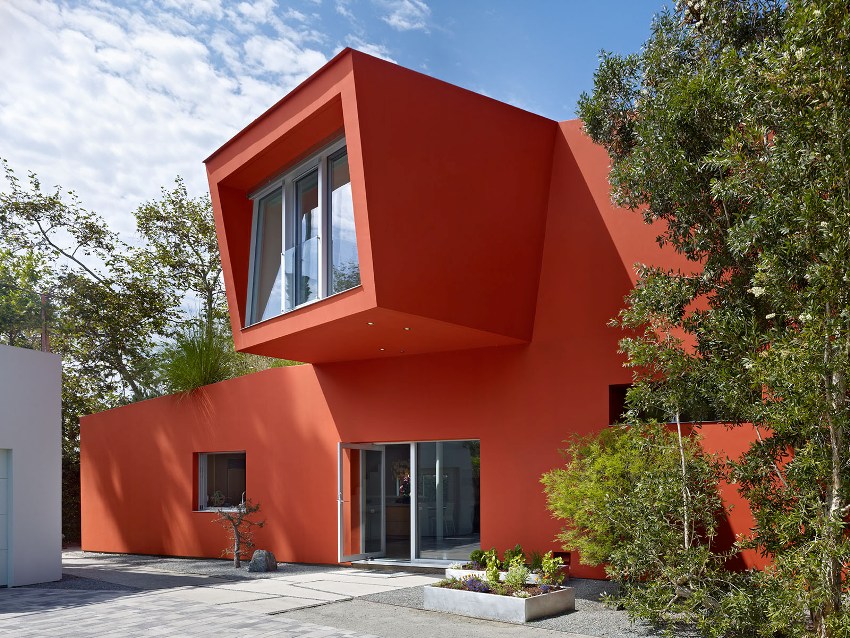
The main disadvantage of plaster is considered to be high flammability, which excludes its joint use with mineral wool
Features of facade decoration with various plaster mixtures
The most common option is considered to be mineral plaster, which is low cost, has a large selection of colors, has good UV resistance and prevents the growth of microorganisms. Low flammability is considered an important advantage of mineral plaster, which is especially important if a flammable insulation was used when creating a facade for a house. You can combine the finish with any base and heat-insulating material.
The disadvantages include the low degree of elasticity of the solution, which can lead to cracks on the facade during the shrinkage of the house, therefore, it is not recommended to apply mineral plaster to the facade of a newly built house. The average service life varies from 10 to 18 years. To maintain a tidy appearance longer, you can update your facade paint as needed.
The composition of acrylic plaster includes a variety of plasticizers that allow the facade to remain intact even during the period of shrinkage of the building. Acrylic plaster, in contrast to mineral plaster, is characterized by a longer service life of over 20 years, high resistance to frost and high humidity. Moreover, its price is slightly higher. In most cases, the acrylic mixture is applied to a pre-prepared foam surface.
The disadvantage is the high flammability of the material, which excludes its joint use with mineral wool. Many people still note the high electrification of the outer surface, which leads to the accumulation of dust in the decorative recesses, which must be constantly removed so as not to spoil the aesthetic appearance.
It should also be mentioned about the method of finishing the facade with "bark beetle" - this is not a separate type of plaster mixture, but only a method of application. The method got its name due to a special pattern that resembles the bark beetle's moves on the surface of a tree. Moreover, the finishing method is used not only on the external, but also on the internal walls of the house.
Unusual decoration with plaster "bark beetle" of the facade of the house is formed due to the presence in the composition of small particles of marble or mineral chips, which, when exposed to polishing, leave characteristic grooves on the wall. The roughness and graininess of the pattern will depend on the size of the granules: the larger it is, the more expressive the grooves on the facade will be. In the photo, the facade of the house "bark beetle" looks attractive, and the application features can make each house unique. Other benefits include:
- the ability to hide even significant irregularities on the base surface;
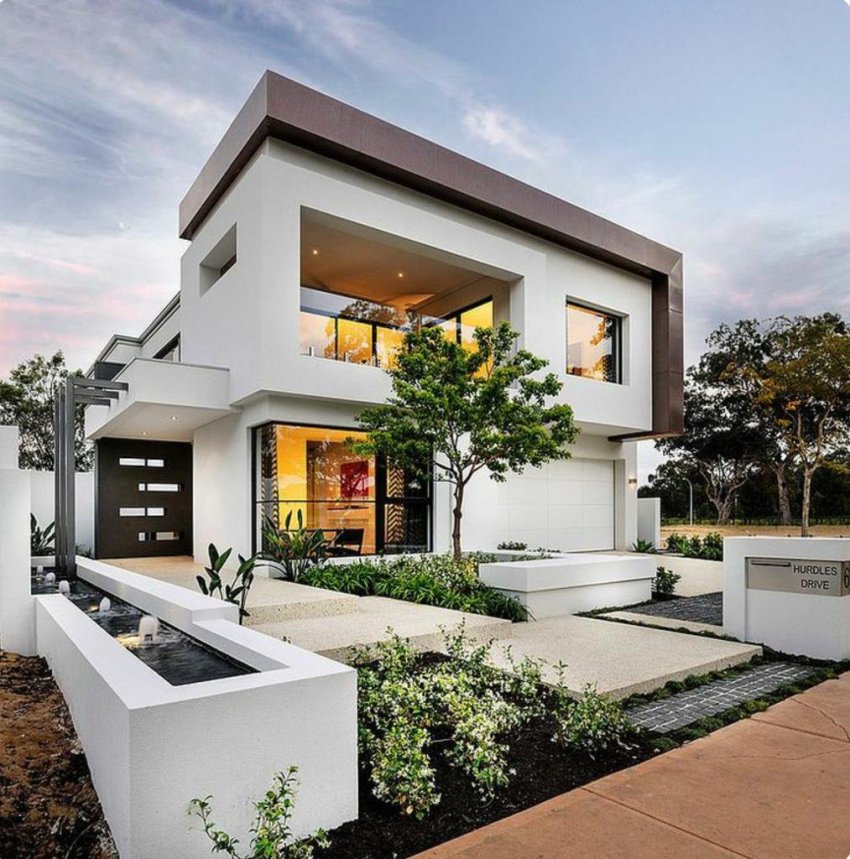
The plaster can be easily cleaned from dirt with water, lasts for a long period, does not allow salts and chemicals to pass through, and is resistant to temperature extremes
- resistance to mechanical stress;
- attractive appearance.
In addition, even a novice master can use this method of applying plaster. For work, you do not need to purchase an expensive tool, and the result of your work, in any case, will be a beautiful facade. To make it easier to determine the texture, below is a selection of photos of facades "bark beetle".
Related article:
Decorating the outside of the house: ways to strengthen the building and make the facade attractive
How to carry it out and prepare the foundation. The main types of materials: plaster, natural and artificial stone. What to choose: plastic, metal or wood?
Silicate and silicone plaster: the main characteristics of the finish
Silicate plaster is made using potash glass, which gives the mortar ideal performance. Due to this composition, the silicate mixture is characterized by the longest service life even under adverse environmental conditions.
Useful advice! The unique composition of silicate plaster provides the mortar with the longest service life compared to other plaster mixtures. The average duration is 30-35 years.
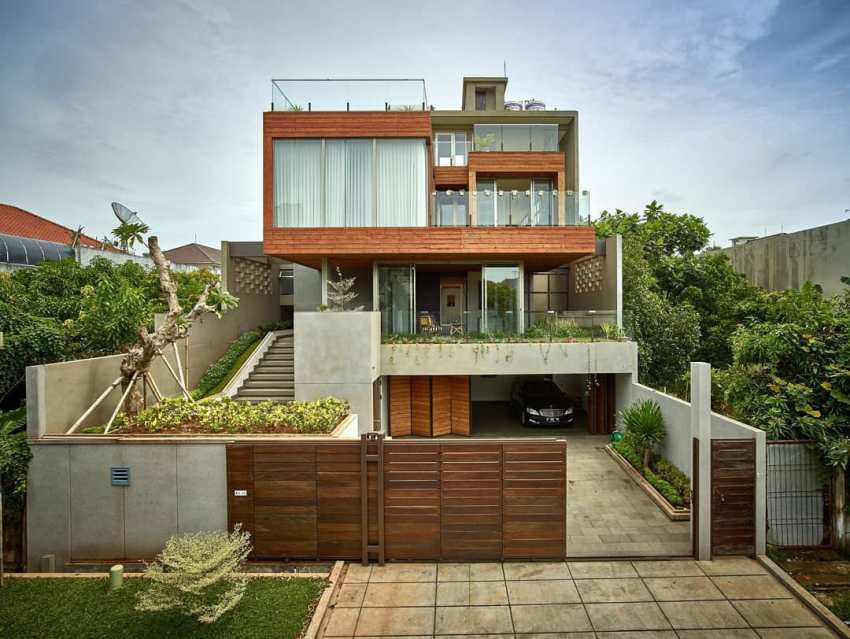
Silicone plaster not only serves as an excellent protection for the external walls of houses, but also is an excellent insulation
The material is considered the best option for finishing the facade of a private house, which has just been erected, because good elasticity, even after complete drying, prevents the development of cracks on the surface. The solution is also suitable for renovating an old house in which you need to refresh the facade.
Neutral electrostaticity does not provoke dust deposition, and dirt from the surface is easily washed off even in rain. Like other plaster options, it has good moisture-repellent and thermal insulation properties. In the photo, the facades of private houses, made with silicate plaster, look beautiful and attractive. Despite this, the cladding also has some disadvantages, including:
- high price;
- small range of color selection;
- fast drying.
Due to the fact that the mortar after mixing sets for a maximum of one and a half hours, this can cause some difficulties when applied by an inexperienced builder who decided to make the cladding on his own. Therefore, in the absence of such skills, in order to avoid damage to the building material, it is recommended to seek help from specialists. In addition, it must be borne in mind that before using the solution, work should be carried out on surface preparation, for which a special primer layer is applied. It is not recommended to use polystyrene as insulation when decorating the facade of a private house with silicate plaster.
Silicone plaster is practically devoid of drawbacks if the issue price does not matter when buying. The material has several advantages:
- durability;
- shows excellent wear-resistant qualities;
- has optimal vapor permeability;
- does not absorb moisture.

Silicate plaster is the most expensive in terms of price, resistant to mechanical stress, vapor permeable, has high heat and sound insulation properties
The solution has become widespread when performing exterior decoration of the house due to its low degree of flammability, the ability to self-cleaning. The coating perfectly prevents the deposition of not only dust on the facade, but also salt particles and other harmful substances. For these reasons, the composition is recommended to be applied to houses built along busy highways and highways or in the coastal area. The method of application does not differ from the technology of other types of plaster.
Natural and artificial stone when decorating the facades of houses: photos of finished options
The facade of the house, the design of which provides for the use of natural facing stone, is not only durable and reliable, but also looks very attractive. Due to the peculiarities of mining, natural stone is distinguished by its high cost, it is rightfully considered the most expensive finishing option, because the installation of parts will be expensive. Another disadvantage of using a stone is a significant weighting of the frame.
Important! If you want to revet the facade with natural stone, you need to calculate this even at the stage of creating a project, because you need a strong and wide foundation designed for heavy loads. For reconstruction of the facade of an old house, stone should be selected only after assessing the condition of the foundation of the house.
When decorating the facade with stone, the following material options are used:
- Granite. The decoration of private houses with granite has been carried out for more than a decade. Due to its physical and chemical properties, the stone is distinguished by exceptional hardness and strength. The presence of quartz in the composition makes the house unusually attractive. A granite façade is expensive, but it can last for over 50 years.
- Marble. It is considered an expensive finishing stone with an attractive light color. In some cases, inclusions of minerals paint the material black or red, and also form overflows and variegated spots on the surface. Marble, unlike granite, is lighter, but prone to darkening.
- Travertine. Due to its attractive appearance, it is suitable not only as a decoration for the facade of a house, but also for interior decoration of a building. The main features are porous structure and non-slip surface. Travertine is heat resistant and easy to process.
- Slate. Most often, a solid stone with a layered structure is used. It has resistance to low and high temperatures, strong structure and good water permeability. The main disadvantage is delamination due to impact or fall.
- Limestone. One of the cheapest building materials due to its widespread availability. The attractive appearance of the plates is ensured by the presence of shiny quartz in the composition. The main advantages are easy handling and frost resistance.
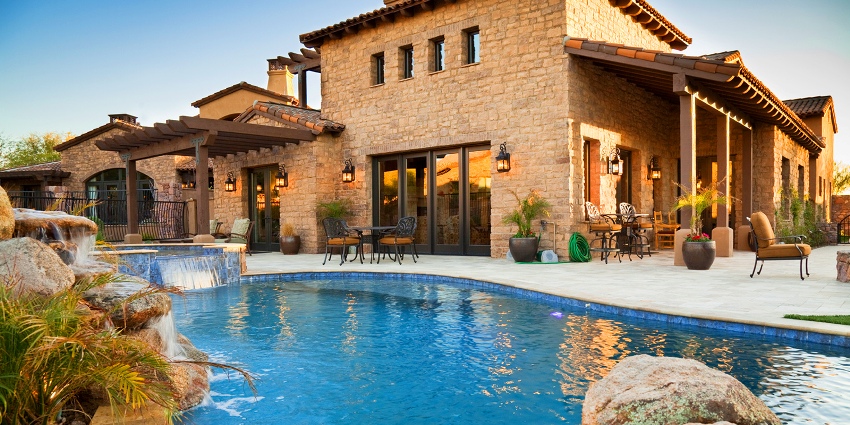
Natural stone has a high cost, therefore it is considered the most expensive option for finishing the facade
Useful advice! If you want to save money on finishing with natural stone, you can make a combined facade of the house, for example, use durable natural granite for facing the basement, and cover the rest with siding for a stone, the cost of which is several times lower, and in appearance it is not immediately possible to distinguish it from stone ...
Artificial stone is made from a mixture of concrete, sand, mineral dyes and plasticizers. Modern technologies have made it strong, stable and much lighter than natural. Other positive aspects:
- long term of use with preservation of appearance;
- low cost;
- high performance characteristics;
- simple processing;
- a large selection of textures and shades.
What does house decoration look like with facing bricks?
Brick has always been considered one of the most popular facade design methods. For this purpose, ordinary building material is not used, but only decorative brick, which is also called facing or facing.
All types of facing bricks differ in their performance characteristics, there is a large selection of textures, colors and shapes. Depending on the chosen design of the facade of a private house, you can purchase glazed, matte bricks or materials covered with mineral chips.There is an opportunity to buy bricks of various shapes: square, rectangular, in the form of a parallelepiped or other shaped processing.
Clinker bricks are produced from plastic grade clay using the pressing and firing method. To give a pleasant shade, a natural dye is added to the mixture. Thanks to high production technologies, the material is distinguished by its mechanical strength and good frost resistance: the finish can withstand up to 300 freeze-thaw cycles while retaining its original properties. The downside is the high cost, heavy weight and complex and expensive installation. A more affordable alternative is to decorate the facade of a private house with clinker tiles, which is easier to work with, and it costs less.
Characteristics of other finishing materials for the facades of private houses:
- Ceramic bricks are made from clay and have a large selection of different options. Its advantages are environmental friendliness, good sound and heat insulation, as well as an affordable price. Minus - a high level of water absorption, which reduces the frost resistance of the facade.
- Hyper-pressed. It is obtained by using cement, shell rock and other additives by dry pressing. Externally it is similar to ceramic, but this type of brick has a higher thermal conductivity and low water absorption. Cons - heavy weight, ability to change color.
- Silicate brick. The basis is a cement-sand mixture, the low cost of which provides a low price for finished plates. Unlike other types of bricks, it has a less attractive appearance, and is also characterized by low frost resistance and a high level of water absorption.
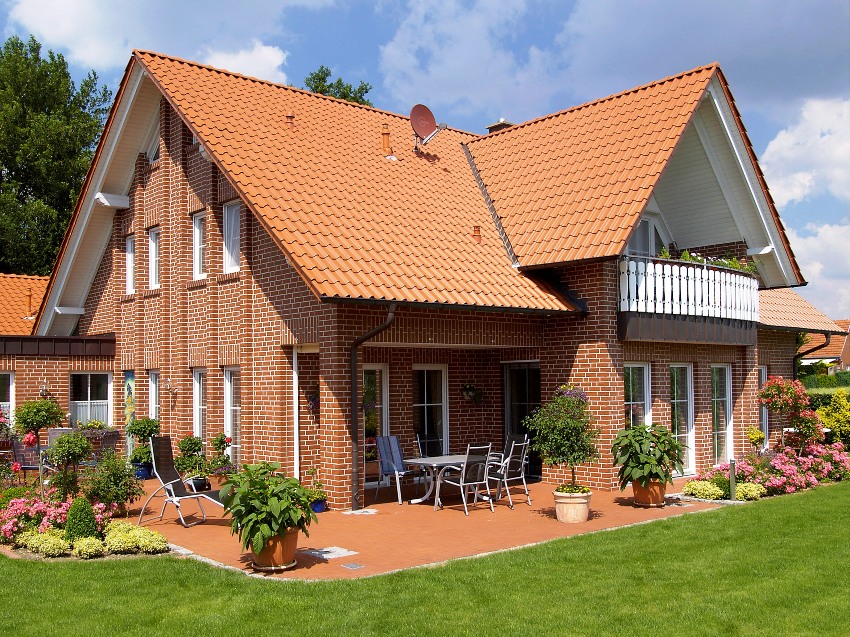
Thanks to a wide color palette, as well as interesting textures of facing bricks. you can implement the most daring design ideas
Porcelain stoneware, ceramic and concrete tiles for the facade of the house
Porcelain stoneware is obtained by mixing clay, quartz sand, feldspar and water using the dry pressing method. It belongs to one of the most durable facade finishing options, and practically does not differ from natural stone in terms of performance. You can use porcelain stoneware on the facade of a wooden house, block or concrete buildings. The base of the building will be reliably protected due to the fact that the material is characterized by absolute moisture and frost resistance. It can be used in regions with extreme temperatures.
Useful advice! A large selection of shades and textures of the material allows you to create any facade design. Tiles can imitate stone, wood, and other expensive materials.
Of the minuses, a specific installation stands out, because due to the low hygroscopicity, cement-based solutions cannot be used - you will need to purchase a specific glue or additionally mount a metal crate. It will be cheaper to finish the facade of a private house under a brick with porcelain stoneware panels than using natural material.
Ceramic tiles for the facade have earned wide popularity due to their good performance and decorative qualities. Unlike the tiles used for interior work, the facade version is distinguished by lower porosity, due to which less water absorption is provided.
On trading floors, you can purchase material of any shape and texture, and you can mount it on any type of facade.
The basis of concrete tiles is cement, quartz sand, filler and additives. In addition to high strength and rigidity, the cladding is not prone to moisture absorption, is durable and at the same time is characterized by a low cost.The disadvantages include susceptibility to temperature extremes and the inability to use for a "wet" facade.
Siding as a popular option for exterior facade decoration: photos of beautiful houses
Vinyl siding is a panel made of high-quality polymer materials, due to which the material is distinguished by high mechanical strength, lightness and a unique ability to withstand atmospheric influences. It is used as a decoration for the facade of a wooden house or any other version of the box. The structure is PVC panels made using the double extrusion technology.
The inner part consists of a rigid layer, which occupies 80% of the total volume, which gives the panel rigidity and prevents deformation. The upper thin layer protects the surface from external influences and helps to maintain a bright shade. Depending on the type of building, you can pick up panels that imitate wooden lining, timber, stone or tiles. Finishing the facade with siding is quite cheap, but when working you need to take into account the relative fragility of the sheets.
Important! Vinyl siding does not fit well with other finishes, so it is better to finish the entire facade with panels. It should be borne in mind that when burning, the material releases toxic chemicals that have a detrimental effect on the body.
When making decorative facades from wooden siding, dried wood or material treated with antiseptic agents is used. The main advantages of finishing include:
- aesthetic appearance;
- use of material of natural origin;
- good resistance to temperature extremes;
- optimal vapor permeability.
The tree has good thermal insulation properties. In addition to the advantages, the material also has some disadvantages, where complex care is considered the main one. The natural origin of the tree requires constant pest control and application of fire-fighting agents. Another disadvantage is the short service life. Even if wood-pulp siding is preferred, it still won't last longer than 15 years.
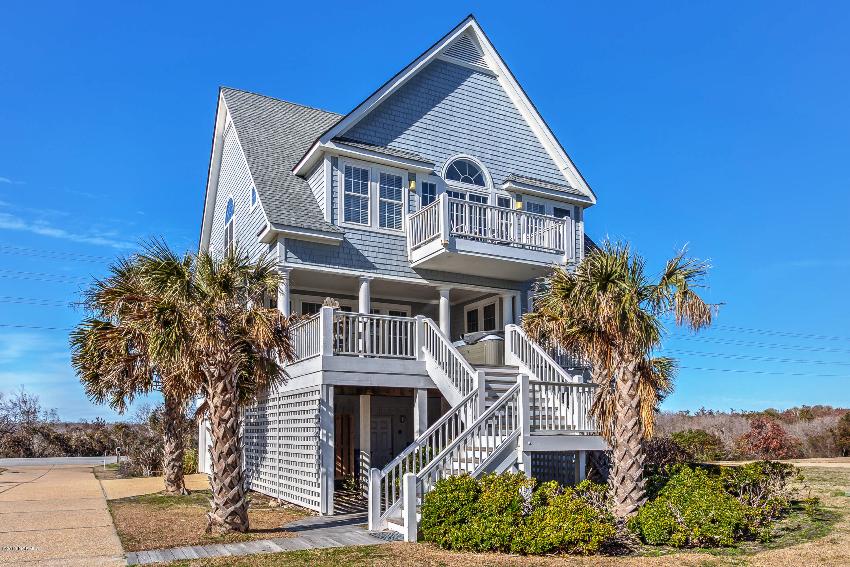
Siding facades do not burn, look incredibly attractive, stylish, act as a reliable protection for building material
Finishing the house from the outside with facade panels fiber cement, metal and cement siding
Metal siding is made from aluminum or steel, the finished panels are primed and polymer coated. Finishing the facade of cottages with aluminum siding is expensive, so they prefer to purchase galvanized steel sheets. To add color, two coatings are used:
- polymer;
- powder.
The main advantage of metal siding is its long service life, which reaches 50 years. The material is characterized by low flammability and relatively simple installation. The application of special layers prevents the appearance of corrosion and rust.
In the composition of cement siding, in addition to the main material, cellulose fibers are present. Due to the peculiarities of production, this type of panel is not inferior in characteristics to artificial stone. The sheets are heat-resistant, strong, but have a rather large weight, which creates difficulties during installation.
Fiber cement panels for finishing the facades of private houses came to the domestic market relatively recently, but immediately became popular. Modern technologies allow sheets to maintain an aesthetic appearance that is not inferior in attractiveness to wood trim.
In terms of strength characteristics, sheets can be compared with concrete.Ease of maintenance is considered an advantage, because the sheathing is perfectly self-cleaning. Unlike vinyl, fiber cement panels for facades are characterized by strength, which greatly simplifies their installation, and they can be easily combined with other types of finishes, including glass elements, if you plan to create a high-tech facade.
Modern trends used in the design of facade design
A large number of styles are used for the interior and exterior decoration of the house; it has also become popular in recent years to combine several different directions on one facade, creating a single picture. The main current trends in the design of the facade of the house:
- simple shapes and clear lines;
- panoramic windows that fill the interior space with light;
- the minimum amount of decor.
Increasingly, modern architects are trying to reduce the number of decorative elements of the facade, filling each detail with a certain functionality and practicality. That is why various lighting fixtures can be seen on the outer surface, highlighting a certain part of the building.
Another rule to which they strive when decorating the facade of a building is the use of natural materials or analogues that imitate natural textures. It is also popular to perform combined facades that give originality to the appearance of the building.
Important! Whichever style is chosen for finishing the facade, the main thing is that it matches the environment and the mood of the owners. It is important to think over the external design even before creating a project, because some options for facade materials are distinguished by a large weight, for which the foundation should be designed.
The most popular option for finishing the facade is the minimalism style, which prefers the use of clear lines and laconic forms. There is no desire for luxury or pretentiousness here. Excludes the application of abundant decor on the facade and the use of too bright colors. Other characteristic features are the simplicity of the facade and the absence of complex finishes. Minimalism provides for a large number of windows, creating a monochrome exterior with light colors. The exterior walls are lavishly decorated with LED lighting, which highlights the most significant façade elements.
The high-tech style is somewhat close to minimalism, it also presupposes clear lines and regular geometric shapes. You can often see the use of white or gray metal siding, but plastered facades in the same color scheme are also popular. It is important when creating a high-tech design to equip the house with functional engineering items that will also play the role of decor. These can be large windows of the correct geometric shape, even better round ones, which with the help of the remote control completely disperse to the sides, or unusual doors.
If we talk about a modern loft style, then it provides for the placement of massive ventilation systems, pipelines, wiring and other utilities on the facade.
What the facades look like in a classic design
Classic facades will always be relevant, especially for people who are conservative and like to adhere to traditions. Classic directions involve the execution of facade decoration with wood or stone, as well as a combination of these materials. In this case, it is appropriate to use luxurious decorative elements:
- columns;
- stucco molding;
- massive windows;
- shutters.
Due to the fact that the style provides for the application of high-quality and natural materials, the design of the facade will not be cheap, but the classics are unlikely to ever go out of fashion and will impress the guests of the house for a long time.
The country style in the design of the buildings was borrowed from films about American ranches. In this case, the facades are predominantly faced with clapboard, wooden siding or other wood-like material. Sometimes the facade, in addition to lanterns, is decorated with other decorative elements.
Often, in the design of facades, Mediterranean motives are used, providing for the use of warm colors on the facade. In addition to the main windows, it is acceptable to make a number of small windows on the facade, giving the building an infinity effect. Such houses often have semicircular balconies, niches and other elements. In this case, the external walls are mainly finished with various plaster mixtures.
Why do you need to carry out timely repair of the facade of the house
The facade, unlike the interior, is constantly in full view of guests, neighbors and passers-by. Therefore, it is important to conduct an audit of the walls from time to time in order not to miss the beginning of destruction, which at first is cheaper and faster to fix. It is important to understand that the facade experiences various kinds of loads around the clock - these are heating and cooling, the effect of wind with dust particles, all kinds of precipitation, including hail and dew.
Useful advice! In order not to frequently repair the facade of a private house, you should properly care for the cladding. It is necessary to treat the tree with mixtures, renew the painting on the plaster, glue the fallen stone or other panels.
Before planning repair work, it is recommended that if problems are detected, a complete survey of the entire facade is recommended. In some cases, a latent violation of the integrity is possible, tracked by the condition of the internal walls, which are constantly damp or covered with fungus. In general, there are three types of facade work:
- partial. It is mainly performed after mechanical damage in a certain external part of the building. Provides for the removal of the damaged layer with its replacement with a new one;
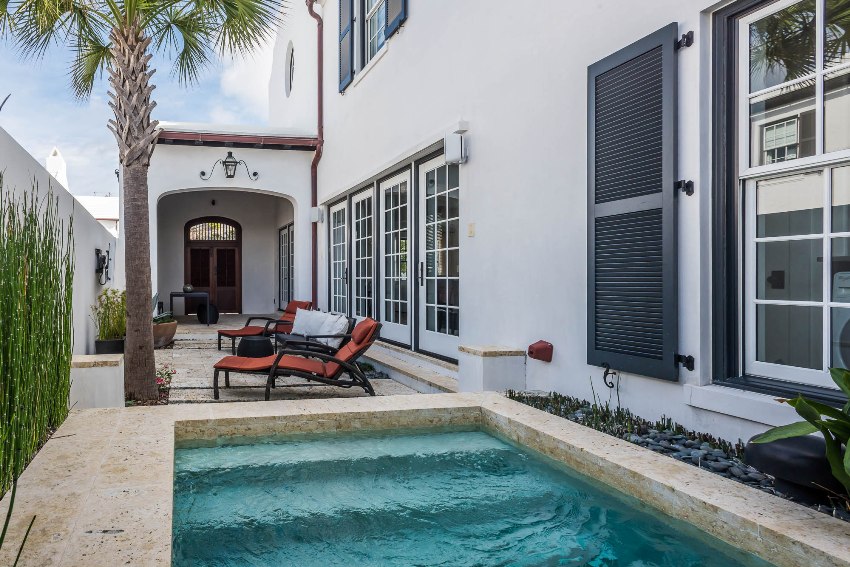
It is important to repair the facade on time, as it is constantly experiencing various kinds of stress
- cosmetic. Includes antifungal treatment, touch-up or surface cleaning. The more often cosmetic work is carried out, the longer a thorough repair is postponed;
- capital. The most expensive option that requires a complete renovation of the facade. It is used for significant violations, when minor repairs will not bring results.
The exterior of the façade is not just the face of the house: its appeal is a reflection of the owner's taste and mood. External finishing plays an important role in protecting the internal structure of the house, because it protects the frame from the negative effects of natural forces, and most importantly - from moisture, which is destructive for most materials. If you do not have experience in carrying out facade work, it is better to entrust the finishing to professionals who can give a guarantee for their work.

